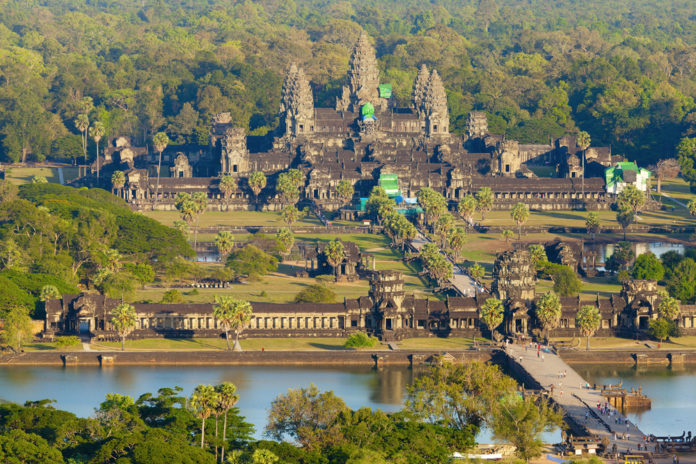The city that has decorated the Cambodian national flag since 1993 symbolizing justice, heritage, and integrity and that has left Europeans baffled for centuries – Angkor Wat. Angkor Wat directly translating to ‘Temple city’ is the largest pre-industrial city in the history of the world. It is also the largest religious monument ever constructed by land area in the world encompassing about 500 acres of land located six kilometers north of Siem Reap, Cambodia. The history of the Madhidharapura dynasty has catalyzed many bewildering Khmer architectures confining their narratives, among which Angkor Wat till date stands tall to be one of the most sophisticated builds of all time. Built roughly between A.D. 1113 and 1150 by one of the greatest rulers in the history of the Madhidharapura dynasty- King Suryavarman II posthumously named Paramavishnuloka, the monument honored Hindu God – Vishnu. However, during the late 12th century, this Hindu state temple had been converted into a Buddhist temple by King Jayavarman VII which remains so in the present day.
Angkor is a city that was planned and constructed based on certain Indian religious and political concepts for administration and worship of the divine king. From the time of Yashovarman I, who named the city Yashodharapura, Angkor was coined as a universe that was meticulously structured according to the traditional Hindu cosmological model. Most of the temples at Angkor, all of which were designed according to the Indian cosmological and mythical themes, were built to make sure that the king and other royal members attained immortality beyond death by being identified with other supereminent gods of the realm. This ancient crumbling city subsequently believed to be a funerary temple for King Suryavarman II symbolizing the link between the setting sun and death given that its entrance faces towards the left (honoring Lord Vishnu) unlike other conventional Khmer temples. Given that the Khmer architecture employed Hindu cosmology to symbolize the idea of a perfect world in geometrical harmony, the long sandstone causeway leading to the center of the temple from the sanctuary was believed to be a route towards salvation through wisdom.
The two fundamental plans of Khmer architecture were used in the construction of this confounding monument- the temple mountain and the galleried temple, extracted from the Dravidian architectural plans. The temple-mountain plan deciphers the abode of Hindu gods- Mount Meru. The four inter-nested enclosure walls and the moat surrounds the temple cosmically representing the mountains and oceans respectively. They are believed to depict the obstacles one must come across through spiritual awakening towards the path of enlightenment. The heart of the structure is the five peaked central towers also termed a quincunx rising to 65 meters tall representing the five peaks of Mount Meru. The sandstone has been used as the main building material for this 213 m long temple which was later beautified using laterite. The binding agents have been predicted to be resins however, they have not been confirmed. The walls of the out gallery of this extravagant monument are intricately designed with carvings illustrating legends of Hindu ancient culture of both Ramayana and Mahabharata and its religion in the Cambodian language and in Sanskrit as well. Some important events of Khmer history have also been ornately described via these high-quality bas-relief carvings which are about 800 m long and three tiers high.
Besides their cosmic importance, the moats and reservoirs were an important part of the everyday life of Angkor for agriculture. The fifteen-foot-high wall, part of which is still standing apart from symbolizing mountains also served the purpose of protecting the city and its residents. Furthermore, the two large Barays in the east and the west one 7.5 km long, 1.83 km wide, and 4-5 m deep, and the other twice as large as the previous were constructed to store water during heavy rainfall and store water preventing flood during the monsoons. They also greatly contributed to the irrigation system for crop cultivation during dry seasons due to which Khmer people could cultivate crops and rice two to three times every year.
Chinese diplomat under the Yuan dynasty- Zhou Daguan visited Angkor in 1296-1297 and recorded the daily life of the Khmer capital. He remained at the court King Indravarman II and his resultant report titled, ‘The Customs of Cambodia’ is an important source of information that assisted in understanding the history of Angkor. The book very well described the customs practiced by the residents, the trade, agricultural advancements, and the war with Siamese. The book elucidates the pronounced role of women in trade. In his book he describes Angkor to be a large, thriving metropolis and one of the magnificent capitals in all Asia. The last stone engravings in the temple are up to 1327 which marks the end of the classical Khmer era. During 1352-1357 Angkor was sacked by Ayutthaya Thais which followed the abandonment of Angkor after invasion by Siam (present day Thailand). The French established a commission to restore the site for tourism purposes in the early 1900s who ruled Cambodia for much of the 20th century.
Angkor Wat being a complex and wise architectural monument though known to locals was rediscovered and attracted attention after the publication of travel notes written by a French naturalist Henri Mouhot in 1863 about his visit to Angkor Wat in 1860. In 1992, Angkor Wat was listed as a UNESCO World Heritage site. Today it serves as a landmark welcoming around 5,00,000 visitors every year to witness its unique history and architecture despite the significant damage it has sustained over the years owing to regional conflicts and forest overgrowth.
By Pooja Naik, Mumbai
















